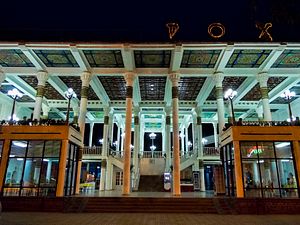Late in the evening on September 29, a bulldozer tore through the first house slated for demolition in Tashkent’s Janggoh neighborhood. By the end of the night, 79 homes total would be razed to clear land for the future embassies of China, India, and Tajikistan.
This isn’t the first instance of forced eviction in Uzbekistan; over the years, many hundreds of families across the country have been kicked out of their homes at a moment’s notice for government-funded construction projects. In May, at least 2,000 people were forcibly removed from their homes in Andijan. Their houses — where some residents had lived since childhood — were torn down to make room for new apartment buildings, which stand to make a pretty profit for the private construction companies building the apartments as well as the regional government, which can charge future residents for using state-owned land.
Rent-seeking and corruption can partially explain the trend, but they don’t entirely capture the range of incentives driving Central Asian governments to reshape urban landscapes with impunity. In her newly released book The Geopolitics of Spectacle, Syracuse University professor Natalie Koch argues for treating architectural spectacle as a conscious political tactic, rather than just a manifestation of dictators’ pathologies. “Urban icons such as the Burj Khalifa are often the subject of tremendous pride for locals when positive identity narratives like modernity are mapped onto their image,” she writes, warning that it’s a mistake to “dismiss them as monuments to megalomania.”
Indeed, narratives of progress and modernity are built into the foundations of the shiny skyscrapers and glitzy high-rise apartment buildings going up in capital cities across Central Asia. Bakhtiyor Nishanov, an analyst at the Washington-based International Republican Institute, described sweeping reforms and plans to overhaul Tashkent city’s urban landscape as “a tangible sign that says: we are open for business” in a EurasiaNet article published last October.
While urban development can certainly be a point of pride for locals, residents of neighborhoods that have been ripped up for modern-looking buildings have not taken the evictions and demolition orders silently.
Even in Turkmenistan, one of the world’s most repressive states, people have gathered in protest of massive construction projects. An estimated 50,000 people were displaced and thousands of houses torn down as part of a city beautification and urban development initiative in advance of the Asian Indoor and Martial Arts Games in September 2017. In February 2017, a group of 40 women demonstrated against the demolition of their homes in Ashgabat. The group of women may have been small relative to the total number of families affected by construction, but their bravery in speaking out demonstrates how important the issue is.
Houses and historic landmarks alike are potential targets for bulldozers in Dushanbe, too. Chaikhana “Rokhat” — the country’s largest teahouse and one of the most prominent buildings on Dushanbe’s main avenue — has been rumored to be slated for demolition.
Residents of Tajikistan, where the government has also been known to limit free speech and access to information, organized a petition to save Chaikhana “Rokhat” and several other Soviet-era landmarks from destruction. “We, the residents of Dushanbe, appeal to you, as a last resort, to prevent a monstrous historical mistake,” the petition begins. “We call on the authorities of Tajikistan to reconsider plans for the demolition of these historic buildings and the destruction of our common history.”
In July, a Dushanbe city official announced that the government had not officially decided one way or the other about tearing down Chaikhana “Rokhat” — giving some hope that the digital activism had worked to save a landmark. Grassroots efforts, which continue to record and protect the region’s rich architectural history, demonstrate an alternative path to urban transformation that doesn’t leave residents in the dust.

































